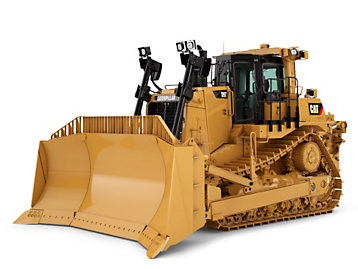By Lonnie Fritz Heavy Construction Industry Consultant Caterpillar Inc. (Guest Post)
Most contractors agree that project success is largely determined by four factors: time, cost, quality and safety. But there isn’t a “one size fits all” approach. The same is true of technology, in that each company’s journey is unique. In this article, Caterpillar will help you take a quick look at key areas where technology can make a difference.
Get Rid of the Paper Trail, Design a Digital One
Running from the jobsite to your office or trailer to update, print and distribute information eats up time, one of your most critical resources as a project manager. Here at Caterpillar, we say stop chasing the paper trail and instead adopt cloud computing. The cloud platform simply means that users with an internet connection and approved access can get “live” information from anywhere. Do you check your email on your smartphone? You’re already using the cloud. Listed below are eight quick ways the cloud can save you time, money and headaches:
- Rapid decision making as personnel can connect with each other from almost any location.
- Faster response time to RFIs (Requests for Information), change orders and purchase orders.
- Snap and send photos of jobsite activity.
- Check manufacturers’ instructions.
- Confirm calculations.
- Instantly look up specifications and special provisions.
- Quickly check contracts.
- Track weather.
Get Your Crew on the Same Page, Even with Different Devices
Smart devices like phones and tablets let employees access and share information with the tap of a finger. 72 percent of construction contractors use smart phones, while 50 percent use tablets. One contractor found that superintendents using a voice-to-text application could save at least 30 minutes a day in preparing reports. There are a wide number of apps that can be useful for your team in the field; here are some of the most widely used:
- Permit apps (for sending and receiving permits).
- Resource tracking apps (tag assets and monitor their location).
- Inventory apps (monitoring items that are depleted & restocked).
- Fleet tracking apps (monitor vehicle routes & fuel).
- Inspection apps (help speed up walk arounds).
- Safety apps (notification system to alert foremen of problems).
- Resource tracking apps (for documenting and submitting employee hours, progress quantities and other day-to-day activities and metrics).
Reduce Risky Business on the Worksite
New technologies (like Cat® DETECT, a Cat Connect Technology) have become available to safeguard worksites and better manage risk. One in ten construction workers is injured on worksites every year. One of the most common accidents on a construction worksite is being struck or trapped by equipment or vehicles. Blind spots and backing up accidents account for 25–50 percent of the total. Here are some of the technologies we recommend that can help prevent such accidents from occurring:
Object Detection technologies
Complete object detection systems include back-up cameras and pulsed-radar object detection. Cameras give operators a view of what is typically their biggest blind spot, and radar identifies objects and people hidden from the operator’s view and sounds an alarm.
Fatigue Detection technologies
Fatigue detection is one of the most recent advancements. A camera installed in the cab monitors pupil size, blinking, and how long eyes stay shut. If the system senses the operator is falling asleep, an alarm sounds and the seat vibrates
“Smart” wearables
Safety gear with Radio Frequency Identification (RFID), sensors and bio-monitors have all hit the market within the last several years. The most common are RFID systems that alert workers and equipment operators when they are both moving through a work zone. Wearable devices are now reading heart rates and body temperature to fend off potential medical incidents.
Stay on Track with Telematics
Most people can use basic telematics information — machine operating hours, location, fuel consumption — to produce measurable improvements in operating costs. 80 percent of new equipment has telematics built-in, so all that’s required is activation. However, only 17 percent of contractors are using telematics within their projects. Telematics provide multiple cost saving benefits:
- Location features help keep equipment and people safe by alerting operators and sounding proximity warnings.
- Telematics can help optimize utilization—because equipment doesn’t get rented when it’s not needed or isn’t parked and forgotten.
- Most OEMs provide apps that allow you to access information via smartphone or tablet, so you can check on equipment condition, fuel burn, idle time or service hours.
- Condition monitoring alerts help control maintenance and repair costs by reducing downtime.
Machine Control & Automation Adds to Your Bottom Line
The introduction of control technologies for grading, compacting and measuring payload has given construction companies more ways to increase production and enhance operator performance. Productivity and cost saving advantages come primarily from:
- Improved accuracy of machine–guided buckets and blades.
- Increased accuracy of automated “assist” features that make the operator faster and more consistent.
- Reduced man hours because fewer workers are needed to check progress/complete jobs.
- Elimination of rework, tasks are completed right the first time.
- Fewest passes achieve proposed grade efficiently.
- Optimal number of passes reach compaction target(s) without over or under compacting.
- Reduced cycle times and machine wear due to payload technologies eliminating over and under loading of hauling units.
- Increased safe operation because operators are more aware of activities and individuals around them.
- Data-driven estimating and planning that accelerates payback periods on technology investments.
Caterpillar is constantly developing and refining advanced technologies to help you make your equipment more productive and efficient. The faster you recognize technology as an essential part of your operation, the faster you will begin to see a difference on your worksites and your bottom-line.
By Lonnie Fritz
(Guest Post)
Heavy Construction Industry Consultant
[ebayfeedsforwordpress feed=”” items=”2″]

